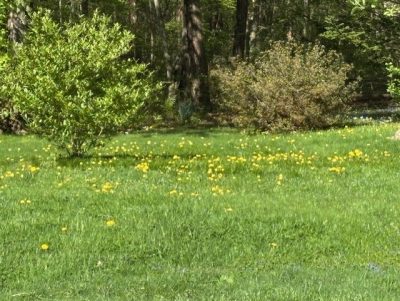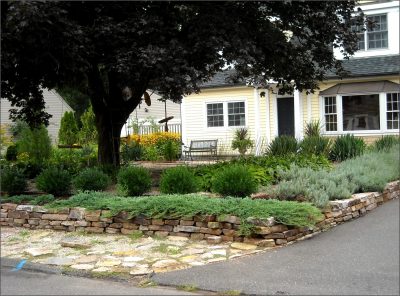By Dawn Pettinelli, UConn Home & Garden Education Center
With the end of summer drawing near and hopefully bringing cooler temperatures and needed precipitation, now is a great time to attend to your lawn. While some of us are reducing the size of our lawns and adding native plants, in many cases lawns still serve a valuable purpose for practical uses, recreation and to set off plantings. Traditional cool season grasses like Kentucky bluegrass, fescues and rye grasses require a higher pH and more fertility than our native soils provide. Right now is the perfect time to add limestone and fertilizer, if needed. Improved soil conditions will assist lawns recovering from the heat and drought stresses of summer. Also, the cooler fall temperatures allow turfgrasses to resume active growth.
Having your soil tested before purchasing limestone and fertilizer is always a wise move. Check out the UConn Soil Testing Lab’s website or give them a call at (860) 486-4274. Many of our soils tend to be acidic with a pH of 5 or so. You might remember that the pH scales ranges from 1 to 14 with 7 being neutral and values below that acidic and above that alkaline. Cool season turf grasses prefer a soil pH in the mid 6’s. When the soil pH is too low, it reduces the amounts of nutrients that are available to turf grasses even if fertilizer has been applied, increases the solubility of toxic elements like aluminum and can cause a decrease in good root formation, contribute to thatch accumulation and affect soil microbes.
Fortunately adjusting your soil’s pH is relatively easy and affordable. Limestone can be purchased either as a ground white powder or in earth tone pelletized forms. There are two main types. Calcitic limestone consists predominantly of calcium carbonates while dolomitic limestone contains both calcium and magnesium carbonates. Usually, dolomitic limestone is more commonly found as it is mined locally and it is fine to use as magnesium is an essential nutrient.

Typically, limestone is applied at rates of 50 pounds per 1000 square feet. If the soil pH needs to be raised significantly, additional limestone can be applied either spring/fall or at 30-day intervals. Once your soil pH reaches the mid 6’s, a maintenance application of 50 pounds/1000 square feet every other year should suffice. Do keep in mind that limestone does take anywhere from 6 to 18 months to change the pH depending on environmental conditions. While some more costly products are advertised as ‘Fast Acting Lime’, studies comparing them to traditional ground or pelletized limestone are inconsistent. If using these products, just follow the instructions on the package.
Choosing a fertilizer is often a confusing task considering the vast selection available. All plants need at least 18 different elements to grow. The 3 that are most often deficient in our soils and components of most fertilizers are nitrogen (N), phosphorus (P) and potassium (K). So, the 3 numbers found on a bag or box of fertilizer, like 10-10-10 or 27-4-6 represent the percent of total nitrogen, available phosphate, and water-soluble potassium, respectively. For instance, a ten-pound box of 10-10-10 contains 10 percent or 1 pound of total nitrogen, and another 10 percent or 1 pound each of available phosphate and water-soluble potassium.
A law passed in 2013, limits the amount of phosphorus that can be applied to established lawns because it is the number one inland freshwater pollutant. Lawn maintenance fertilizers sold in Connecticut will typically have analyses like 30-0-4, 29-0-5 or 10-0-6. While phosphorus applications are prohibited on established lawns, fertilizers with phosphorus can be used when seeding, sodding or overseeding.
Fertilizers are also grouped as either those containing water-soluble nitrogen (WS) of water insoluble nitrogen (WIN). Look for a fertilizer that contains both. That way some nitrogen will be immediately available to your lawn and some will be released slowly over time. Fertilizers containing solely soluble N will produce rapid results but can easily burn if over applied and since some forms of nitrogen are readily leached from the surface soil, more frequent fertilizer applications may be necessary. No more than 1 pound of nitrogen per 1000 square feet should be applied at one time. If grass clippings are left in place then only 2 pounds of nitrogen per 1000 square feet of turf area will be needed each year. The best times to fertilize lawns are in September and in late April through the end of May. Avoid using too much nitrogen as it can lead to increased susceptibility to diseases and lower resistance to stress. If in doubt as to how much lime and fertilizer to apply, consider having your soil tested.
The UConn Home & Garden Education Center supports UConn Extension’s mission by providing answers you can trust with research-based information and resources. For gardening questions, contact us toll-free at (877) 486-6271, visit our website or reach out to your local UConn Extension center.
This article was published in the Hartford Courant September 20, 2025

